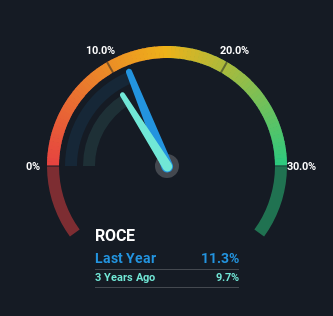There Are Reasons To Feel Uneasy About Reliance Worldwide's (ASX:RWC) Returns On Capital
To find a multi-bagger stock, what are the underlying trends we should look for in a business? Typically, we'll want to notice a trend of growing return on capital employed (ROCE) and alongside that, an expanding base of capital employed. This shows us that it's a compounding machine, able to continually reinvest its earnings back into the business and generate higher returns. However, after briefly looking over the numbers, we don't think Reliance Worldwide (ASX:RWC) has the makings of a multi-bagger going forward, but let's have a look at why that may be.
What Is Return On Capital Employed (ROCE)?
For those who don't know, ROCE is a measure of a company's yearly pre-tax profit (its return), relative to the capital employed in the business. Analysts use this formula to calculate it for Reliance Worldwide:
Return on Capital Employed = Earnings Before Interest and Tax (EBIT) ÷ (Total Assets - Current Liabilities)
0.11 = US$215m ÷ (US$2.1b - US$195m) (Based on the trailing twelve months to December 2022).
Thus, Reliance Worldwide has an ROCE of 11%. That's a pretty standard return and it's in line with the industry average of 11%.
See our latest analysis for Reliance Worldwide
Above you can see how the current ROCE for Reliance Worldwide compares to its prior returns on capital, but there's only so much you can tell from the past. If you'd like, you can check out the forecasts from the analysts covering Reliance Worldwide here for free.
So How Is Reliance Worldwide's ROCE Trending?
Unfortunately, the trend isn't great with ROCE falling from 23% five years ago, while capital employed has grown 388%. That being said, Reliance Worldwide raised some capital prior to their latest results being released, so that could partly explain the increase in capital employed. It's unlikely that all of the funds raised have been put to work yet, so as a consequence Reliance Worldwide might not have received a full period of earnings contribution from it. Additionally, we found that Reliance Worldwide's most recent EBIT figure is around the same as the prior year, so we'd attribute the drop in ROCE mostly to the capital raise.
The Bottom Line On Reliance Worldwide's ROCE
While returns have fallen for Reliance Worldwide in recent times, we're encouraged to see that sales are growing and that the business is reinvesting in its operations. And there could be an opportunity here if other metrics look good too, because the stock has declined 22% in the last five years. So we think it'd be worthwhile to look further into this stock given the trends look encouraging.
One more thing to note, we've identified 2 warning signs with Reliance Worldwide and understanding them should be part of your investment process.
For those who like to invest in solid companies, check out this free list of companies with solid balance sheets and high returns on equity.
Have feedback on this article? Concerned about the content? Get in touch with us directly. Alternatively, email editorial-team (at) simplywallst.com.
This article by Simply Wall St is general in nature. We provide commentary based on historical data and analyst forecasts only using an unbiased methodology and our articles are not intended to be financial advice. It does not constitute a recommendation to buy or sell any stock, and does not take account of your objectives, or your financial situation. We aim to bring you long-term focused analysis driven by fundamental data. Note that our analysis may not factor in the latest price-sensitive company announcements or qualitative material. Simply Wall St has no position in any stocks mentioned.
Join A Paid User Research Session
You’ll receive a US$30 Amazon Gift card for 1 hour of your time while helping us build better investing tools for the individual investors like yourself. Sign up here

